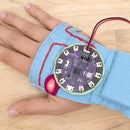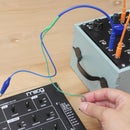Introduction: DIY Quilted Jacket With Pattern
As it gets cold outside, I increasingly don't want to get out of bed. I want to stay wrapped up in the blanket, warm and cozy. There has already been a blanket with sleeves pushed to the market. But it's not exactly something you want to wear outside.
This jacket is a rectangle of cozy quilted fabric, wrapped around the body. It's essentially a blanket with sleeves. this project is recommended for someone who has worked with patterns before. Even though it is relatively simple, it's best to know what a notch and seam allowance are and to be comfortable with taking measurements and possibly altering the pattern to fit.
This Instructable will show how to print the pattern and will give brief instructions on how to alter it. The image of the pattern with measurements is included for reference if you want to drape and draft your own.
Notes on Size
This jacket has plenty of room, so it's size is forgiving. The 3 most important measurements will be gone over later in step 3. Skip to that step if you want to know if the attached pattern will work for you without alterations.
Step 1: Gather Materials
[1.5] yards quilted fabric @63" wide
[7] yards satin blanket binding
[3] yards 1.5" wide cotton twill tape
[4] yards of Double Fold Bias Tape .5" wide
---
Access to a printer
Transparent tape
---
Matching thread
Sewing machine
Scissors
Straight pins
Tailor's chalk
Marker/Pen/Pencil for fabric
Seam ripper
Step 2: Determine Sizing
To give you an idea of the size of the included pattern, it was made for these measurements:
Bust : 36"
Waist : 28"
Lower Hips : 38"
Height : 5' 6"
The pattern for this jacket is attached as well as an image with measurements for reference. This instructable will go on using the printed pattern, assuming that if you want to draw your own, you are savvy enough to do this on your own. Remember to take into account that this will be going over a layer of clothing.
A Quick Prototype is Suggested
Below, for reference, I put the only 3 measurements that you need to check in order to see if the fit will be good. What I suggest to do instead of, or in addition to, is to print the pattern, cut it from muslin or scrap fabric, sew it up and fit. That is the best way to know fit accurately.
Measure
There are a few measurements that you should take to know if the attached pattern will work for you. If the jacket is for yourself, you will probably need someone to help take them.
What's listed below is the measurement taken from the jacket pattern and what margin your measurement should fall in. For example, the shoulder width on the pattern is 19", your measurement should fall in between 18"-20" for a better fit.
1) Shoulder Width
Take the measuring tape and measure from the end of the shoulder bone is to the other on the back.
Jacket measurement = 19"
Your measurement = +/- 1"
2) Sleeve Width
Measure around the widest part of your arm.
Jacket bicep width = 17"
Your measurement = +/- 1.5"
3) Sleeve Length
Start the measuring tape at the just over the bend of the shoulder. Measure down arm, making sure to follow the full length of the arm whilst it's slightly bent. The hem of the sleeve should end at the middle of your palm, if your arm is straight.
Jacket sleeve length = 24"
You measurement = +/- .5"
Step 3: Print and Alter (if Needed)
Print Pattern
Print out the pattern and tape it edge to edge, starting with piece 1 in the upper left-hand corner and moving clockwise. On most printers, there will be a 1/4" white border around the images once printed. Make sure you print at 100% and that your printer preferences don't automatically "Fit to Page". After the pattern is taped together, check out the measurements of the pattern at the three points that are listed above and that you measured previously : Shoulder Width, Sleeve Width and Sleeve Length.
If you need to alter it, see below. If it's good the way it is, go ahead and cut it out.
This pattern has a .5" Seam Allowance.
Alter (if needed)
Use the lines marked "Fold or Add on this Line"
Shoulder width - A
Bicep width - B
Sleeve length - C
To make it smaller, fold the amount that you want to take out inward using the line as the center.
To make it larger, cut along the line and add the needed amount in between the two pieces.
If you alter the bicep width and make the sleeve head wider, make sure to alter the armhole to accommodate for the added amount.
Step 4: Trace and Cut
Cut Fabric
Lay the body pattern piece down on the quilted fabric, it should take up all of the width (or nearly). Before tracing with the chalk, check to see you can get two sleeves out of the remaining bottom fabric, you should have plenty of room.
Trace the patterns pieces with chalk, marking all notches.
Notches to Mark
Body
[1] at the shoulder
[1] underarm seam.
Sleeve
[1] Shoulder (top of sleeve head)
Use pins or chalk to mark where the dashed rectangles on the pattern are, these four rectangles mark where the closure ties are sewn. These are for reference, the jacket should be tried on to get accurate placement once it's sewn.
-----
Cut out the pattern pieces:
[1] body
[2] sleeves
Step 5: Bind Body and Sleeve Edges
Binding
Before the sleeves are sewn to the body, the raw edge of the body and the hems of the sleeves should be bound with the blanket binding.
To do that, first take a look at the binding, there is the middle fold with the two halves on either side, one half will be shorter than the other. The binding is sewn with the shorter side up, so the longer side will be caught beneath. Pin the binding along the edge with the short half on the right side of the jacket every two inches to keep in place.
While you are pinning you will reach a corner, once you do, bend the binding around the corner, pinch the triangle flap that will pop out and fold it over to one side. Pin in it place. When you have gotten all the way around the body and come to meet the starting point, cut the binding so it extends about 1" past, fold the cut edge inward and then fold binding to hide the raw edge inside.
Once it's all pinned in place, sew it down using a regular straight stitch. Take your time, checking to see if the bottom is being caught.
Next, move on to the sleeve hems, pin the binding, cut to length and sew in the same manner.
Step 6: Pockets
Pockets
Pocket's didn't end up on this jacket (I may add them later), but you still may want to add some and now is a good time to do that.
Cut out what ever dimension will fit your wallet, phone, digital caliper, or whatever else you walk around with in your pocket. 8" x 9" is a pretty good dimension. If you cut out pockets, bind what will be to the top edge of your pocket. Turn under the remaining 3 edges .5", pin and sew down.
Step 7: Sew in Sleeves
Take each sleeve and fold it in half, lining up the raw edges. Pin every 2" down the seam and sew, being careful to take the pins out as you go. Sew a .5" seam allowance up both sleeve seams.
- Take the armhole of the sleeve and pin it in the armhole of the jacket, right side to right side.
- Line up the shoulder notch and the underarm seam with the underarm notch.
Once you do, the circumference of the sleeve head will bunch up a little, you will need to ease in the extra length.
Ease
To do this, sew a basting stitch with the sewing machine around the head of the sleeve, leave at least 4" of thread at both ends and pull the ends to gather the ease in. Or you can distribute it by hand and pin every .25" or so. There should only be .5", so there isn't too much extra to ease in.
Pin the sleeves in the armhole of the body, pin and sew in place. Again, take your time here, it's easy for the fabric to get pinched as you go. Make sure it all looks smooth as you go.
You can see more detail in this "How to Sew a Sleeve With Ease" ible, including how to fix an tuck in the fabric.
Step 8: Bind Underarm and Armhole
After the sleeves are sewn in, use the double fold bias binding to bind the underarm sleeve seam. Remember to have the longer folded side on the bottom, so it catches while you edge stitch the short side down. Fold in the raw edges before folding the binding over the seam allowance to finish an edge.
Once you bind both sleeve seams, move on to the armholes.
Trim down the seam allowance if you need, pin the binding on and sew.
Step 9: Adding Ties
You now have a jacket! Only things left are the closure ties. There are 4 strips in all, 2 strips that will tie together inside the jacket and 2 that will tie together on the outside.
Cut
Cut the wide twill tape into four 18" strips.
Mark
To figure out where the ties should go, you can go by the markings you previously made from the pattern OR try it on and mark where they should go with the tailor's chalk. To mark the inside ties, fold the shorter end of the jacket in first and see where the edge comfortably hits the side, below the armhole, and mark. For the outside ties, fold over the other half of the jacket and see where the edge comfortably hits the side and mark. Pin the ties on, put it on and test the placement.
Sewing
Pin the ties in place with the loose ends extending towards the back.
Creating two rows of stitching, sew 1/8" and 3/8" from the raw edge.
Then fold the tie back on top of the stitch lines you just made and stitch 1/2" from the fold, covering the previous stitch lines completely. This makes for a finished edge and a stronger tie. Repeat on the remaining three ties.
To finish, fold the raw loose ends of the ties 1/4", then fold and stitch 1/4" again, creating a rolled hem.
---
After the ties are sewn down the jacket is done! So much better than a Snuggie, isn't it?





